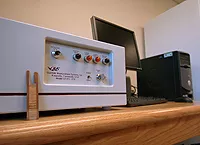BC Government Provides Funding for World Class Forest Research Centre
October 16, 2006
UNBC is a key player in one of the world’s most advanced forestresearch laboratories. EvaluTree is a partnership involving UNBC, UVic,and the Pulp and Paper Research Institute of Canada (PAPRICAN), whichis based in Vancouver.
Click here to access the BC Government News Release
EvaluTree has received $2.5 million in funding from the BC Government’sKnowledge Development Fund (BCKDF), matching an earlier contributionfrom the Canada Foundation for Innovation. It is the largest grant forresearch infrastructure that UNBC has ever received from BCKDF. Whilesome of the research equipment is located in Vancouver and Victoria,the following state-of-the-art technology is being used at UNBC inPrince George:

X-Ray Densitometer
Located in the I.K. Barber Enhanced Forestry Lab, this equipment usesX-rays to gain insight into the wood fibre properties of entire trees,just by analyzing cores from standing trees. It is the only equipmentof its kind in Northern BC, providing information on tree growth rates,fibre density, and wood quality. The equipment will be used in theshort term for research on how water affects wood. This will involveresearch on trees that are particularly dry (killed by the mountainpine beetle) as well as those that are unusually wet (submerged inreservoirs behind hydroelectric dams).

Click here to access the BC Government News Release
EvaluTree has received $2.5 million in funding from the BC Government’sKnowledge Development Fund (BCKDF), matching an earlier contributionfrom the Canada Foundation for Innovation. It is the largest grant forresearch infrastructure that UNBC has ever received from BCKDF. Whilesome of the research equipment is located in Vancouver and Victoria,the following state-of-the-art technology is being used at UNBC inPrince George:
X-Ray Densitometer
Located in the I.K. Barber Enhanced Forestry Lab, this equipment usesX-rays to gain insight into the wood fibre properties of entire trees,just by analyzing cores from standing trees. It is the only equipmentof its kind in Northern BC, providing information on tree growth rates,fibre density, and wood quality. The equipment will be used in theshort term for research on how water affects wood. This will involveresearch on trees that are particularly dry (killed by the mountainpine beetle) as well as those that are unusually wet (submerged inreservoirs behind hydroelectric dams).
Portable Acoustic Tree Assessment Tool
Thisequipment is used for assessing timber quality of standing trees.Forestry professor Ian Hartley is shown using the equipment in thephoto at left. It is a portable device that uses sound waves betweentwo probes. Thespeed that the sound wave takes to travel from one probe to the otheris used to detect internal cracks and/or rot and measure propertiessuch as wood strength. This information is transmitted via Bluetoothtechnology to a portable handheld device (PDA) for further analysis ona computer. Research applications include the shelf life of treesinfected by the mountain pine beetle, routine inspection of utilitypoles, and in-the-field identification of trees most suitable forsecondary manufacturing products ranging from furniture to musicalinstruments.
Both of these tools are non-destructive to standing timber.
Contact:
Ian D. Hartley, Forestry professor, UNBC – 250.960.6054
Rob van Adrichem, Director of Media and Public Relations, UNBC - 250.960.5622